Set With Care, Fire Creates Habitat for Many Declining Bird Species
In a stand of tall, slender pines somewhere in Florida, a fire is burning.
Set widely apart from one other, the trees have scaly, reddish bark and round tufts of needles as long as your hand. The fire doesn't touch the crowns of the trees — instead, it burns slowly along the ground, crackling as it blackens shrubs and trees. Over everything hangs a haze of smoke.
This is no natural disaster. It's a calculated act by land managers to rejuvenate a longleaf pine forest, home to vulnerable birds such as the Bachman's Sparrow and the federally endangered Red-cockaded Woodpecker, and other animals unique to this landscape, such as the gopher tortoise and indigo snake. Without regular fires to maintain the habitat they need, these species and others would disappear.
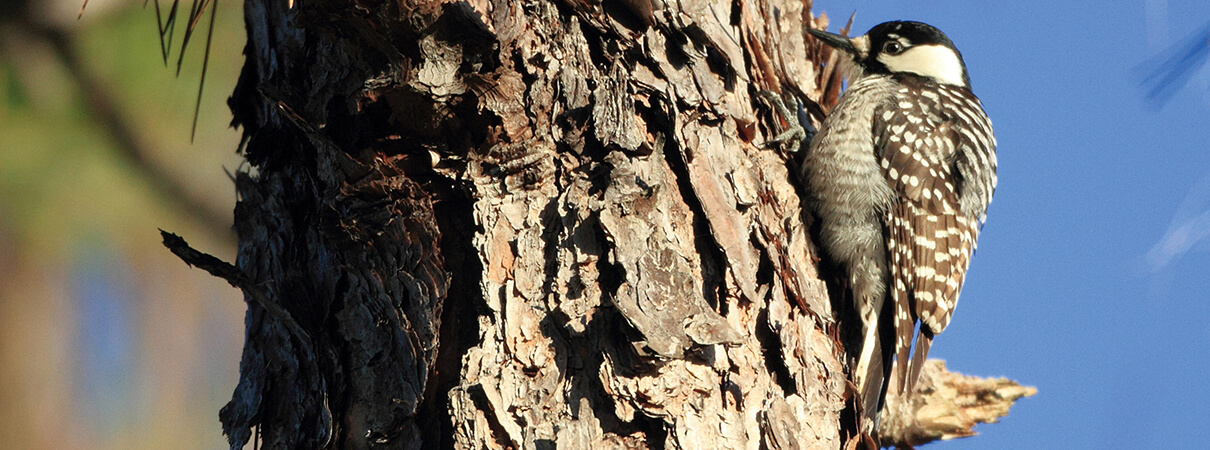
Red-cockaded Woodpecker by feathercollector/Shutterstock
After decades of warnings from Smokey Bear, it's unsurprising that many people view fire as a destructive force. Last summer, news reports were filled with harrowing images of flaming hillsides as massive wildfires blanketed the Pacific Northwest in smoke; two months later, nearly two dozen people died as fires swept across more than 36,000 acres in northern California.
But though fire burns, it also revitalizes. And the fire burning this longleaf pine forest — set carefully in optimal conditions and monitored closely for safety — mimics the natural burns that historically kept trees and shrubs from growing too thick. The technique, known as prescribed fire, is a valuable tool in many efforts to conserve important habitat for declining birds. What used to happen naturally now requires a human helping hand.
A History of Fire
Sparked by lightning, or sometimes by Native Americans who preferred open ground for hunting and cultivation, fire historically has played a role in nearly all of North America's ecosystems.
The details varied from one place to another. Prairies saw fires every year or two that burned standing dry grass to the ground, promoting a new cycle of growth. Mature forests in wetter parts of the continent burned only every century or two. The adaptations of plants in these communities were closely attuned to their local fire patterns. Longleaf pines, for instance, need fire to clear the ground of leaf litter so they can reproduce. If their seeds land in a layer of debris, they won't germinate.
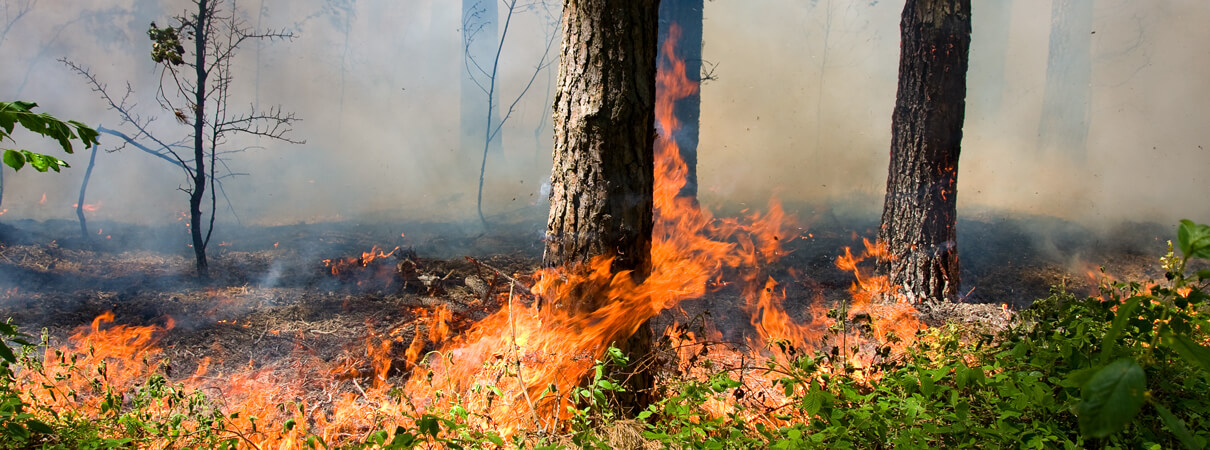
Pine forest burning by OlegD/Shutterstock
Fire was especially crucial in maintaining the availability of what ecologists call early successional habitat, which many birds depend on for foraging or nesting. After a disturbance such as a fire sweeps through a plant community, the series of stages it goes through as it returns to its former state are known as succession.
In an ecosystem where fire is frequent, this short-lived, disturbance-dependent habitat will always be available somewhere, and the birds that specialize on it will always find a home. But when fire is removed from a system, these communities eventually disappear: grasslands become fields, then young forest, then mature forest, and the birds are forced to go elsewhere.
'Like Taking Water from a Wetland'
Removing fire from these systems is exactly what we've done. In the late 1800s and early 1900s, drought and the slash piles left behind in logged forests fueled massive wildfires that killed thousands of people and destroyed towns and cities from the Northwest to Maine.
This spurred large-scale, coordinated efforts by the U.S. Forest Service to suppress fires on public lands, guided by a 1926 federal policy of putting them out before they reached 10 acres in size. For decades, prescribed burning was banned on public lands across much of the country, though private landowners continued to practice it in areas used for farming, grazing, and logging.
Across much of the eastern United States, the result of this suppression was dramatic. Within decades, thick canopies of trees stood over forest floors that were cool, damp, shady — and much less likely to burn. Pine and oak woodlands gave way to hardwoods such as maple and birch, which thrive when disturbance is low and fires rare.
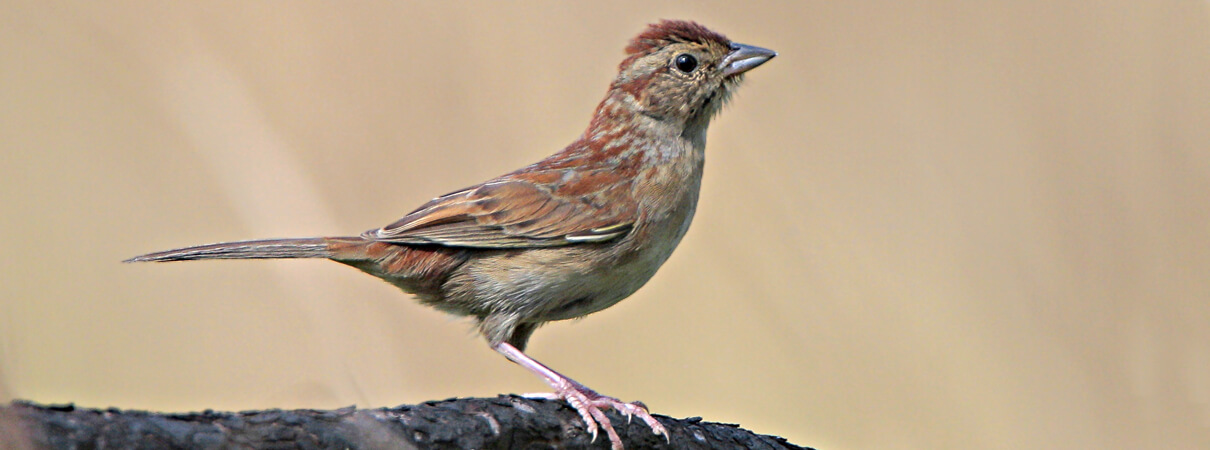
Bachman's Sparrow by Greg Lavaty
“Taking fire out of these systems is like taking water away from a wetland,” says Rob Holbrook, Assistant Coordinator for the East Gulf Coastal Plain Joint Venture (EGCJV), a partnership among state and federal agencies and nonprofits, including ABC, that's working on bird conservation in the Southeast. As woodland and savanna habitat have grown scarce, so have the birds that depend on it.
In this area, it's the Bachman's Sparrows and Red-cockaded Woodpeckers; further west, in the central hardwoods region of Missouri, Arkansas, and east to Tennessee and Kentucky, this change in habitat has hurt Prairie Warblers, Northern Bobwhite, and Red-headed Woodpeckers.
But as land managers and conservationists like Holbrook look for ways to strategically return fire to the landscape, these ecosystems are recovering once again. Red-cockaded Woodpecker populations, for example, have recently been increasing at a rate of 4 to 5 percent per year. As fire management techniques are updated, the outlook for many threatened bird species is beginning to brighten.
From Blackened to Green
The fragmented nature of some habitats in the eastern half of North America means that even if fires do start naturally, they can't spread very far. Nor would we want them to — despite the growing realization that overzealous fire suppression has damaged ecosystems, letting fires burn wildly and threaten homes and infrastructure is no one's idea of good management policy.
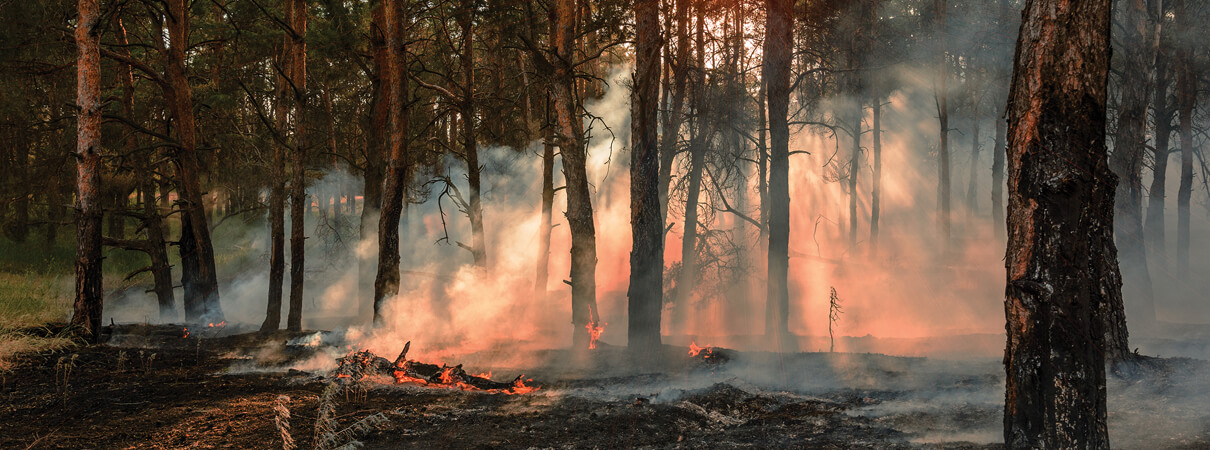
Controlled burn in progress by yelantsevv/Shutterstock
Instead, today's land managers follow a specific plan to create a fire under carefully controlled conditions to achieve a specific management goal. To ensure safety, foresters wait until weather conditions — wind speed and direction, temperature, and humidity — are just right to both keep the fire from spreading and keep the smoke from drifting toward populated areas.
If a site doesn't already have features such as streams and roads that can be used as fire breaks, foresters may create some with bulldozers or other equipment. Then, they ignite the downwind end of the area to be burned so the flames can be carefully controlled. Regardless of size — prescribed fires can be anywhere from a few to several thousand acres — most burns are completed within a single day.
Depending on the time of year and the specific characteristics of the site being burned, a habitat can go from blackened to green in an amazingly short time. “It's really quick. Within two or three days you'll see things starting to green up,” Holbrook says of the longleaf pine restoration. “Say you burn in early summer; by the end of the summer, to the untrained eye, you wouldn't know that a fire had been through there.”
Keep the Fires Burning
From 2013 to 2016, the amount of land in longleaf pine ecosystems under prescribed fire management increased by 50 percent, to over 1.6 million acres. And the birds have noticed. “At our Apalachicola Bluffs and Ravines Preserve in Florida, we've gone from almost never hearing quail or Bachman's Sparrows to having them coming out of our ears” since biennial prescribed burns began in the 1990s, says David Printiss, North Florida Manager for The Nature Conservancy.

Regenerating forest by Virgil Davis/USDA Forest Service/Bugwood.org
One of the biggest challenges with prescribed fire is that the process is never finished. Because fires need to happen every three to five years in many places to maintain early successional habitat and the bird species that require it, managers can never walk away.
“You can't start a program and then quit,” says Larry Heggemann, Delivery Coordinator for the Central Hardwoods Joint Venture. This joint venture is another collaborative conservation effort that promotes the use of prescribed burns to create habitat for imperiled land birds, in this case in the woodlands and glades of states including Arkansas, Illinois, Kentucky, and Missouri.
“It's not like you start, and then when you get it in condition, you're done,” Heggemann says. “You have to keep it going.”
But for the birds, it's worth it. “For birds like Northern Bobwhite and Wild Turkey that spend most of their life on the ground, they've got to be able to get around, especially when the chicks leave the nest. Without fire, often what happens is the groundcover gets so dense that the birds can't walk around,” says Holbrook, of the EGCJV. Red-cockaded Woodpeckers don't live on the ground, but their foraging and nesting requirements are precise, involving pulling loose plates of bark from large pine trees to get at the insects underneath.

Wild Turkey and poult by Kristen Nicholas
“If the understory of hardwoods gets too dense, then it's going to be poor habitat for the woodpeckers,” Holbrook says. “Fire keeps the pine as the dominant tree species and keeps the oaks and other hardwoods suppressed.”
Creating a Mosaic
Fire isn't always good news for birds, of course. When it gets out of control and enters habitats where it doesn't belong, it can become a serious threat.
Barba Azul, an ABC-supported nature reserve in Bolivia run by the conservation organization Asociación Armonía, protects an expanse of seasonally flooded savanna and grassland. Interspersed throughout are small islands of forest that provide crucial habitat for the critically endangered Blue-throated Macaw. Left to its own devices, this habitat would naturally burn roughly every 15 to 20 years during the rainy season, when wet conditions would keep lightning-generated fires from spreading too far or burning too hot.
But cattle ranchers who use the lands surrounding the reserve for grazing now set fires every year to promote the growth of fresh, young grass for their cattle. Although some ranchers do their best to time burns for, say, the approach of a rainstorm that will keep fires under control, this is hard to predict. In recent years, fires have spread into the reserve, damaging roosting and foraging habitat for macaws. In 2015, 80 percent of the savanna habitat in one area of the reserve burned.
In 2016, ABC was one of several organizations that helped the reserve purchase a tractor to dig fire breaks, which has helped turn the situation around. And even here, land managers still see the potential of fire as a conservation tool.
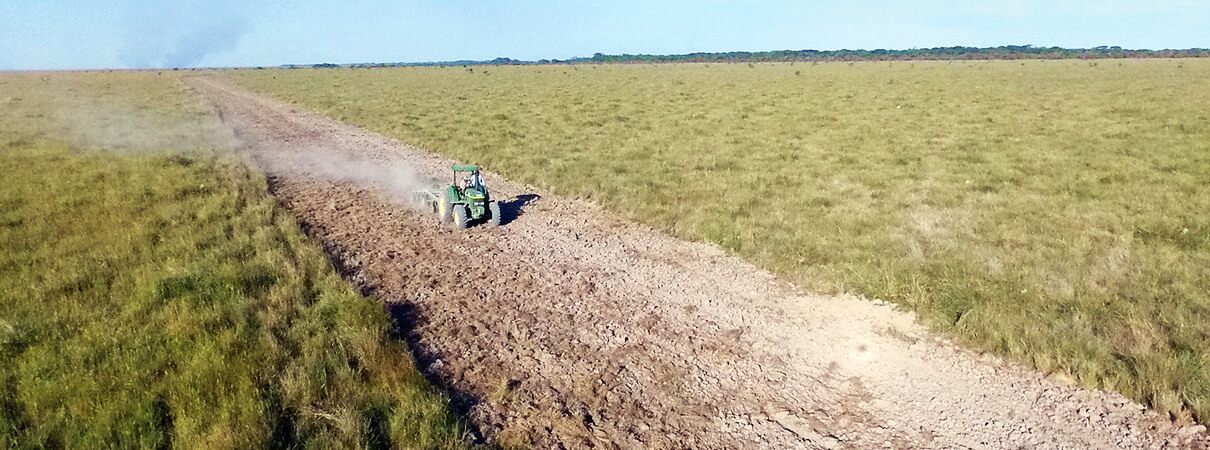
Fire break creation at Barba Azul/Tjalle Boorsma
“Fire is part of this ecosystem,” says reserve manager Tjalle Boorsma. “We try to block it completely now to stop fires that go out of control from our neighboring ranches, but we would like to implement it in the reserve at some point.”
Around 10 percent of the habitat would have burned naturally each year, Boorsma says. Using prescribed fire on a small portion of the reserve's savanna habitat annually, he predicts, could help birds such as Streamer-tailed Tyrant and the vulnerable Black-masked Finch, both of which depend on savanna to survive. “What you'd get is a mosaic of different age classes of savanna, and you'd have a wide range of biodiversity using that landscape.”
Thousands of miles away, back in the U.S., a prescribed burn has done its job. The fire in Florida's longleaf pine forest has burned itself out. Within a few days, young grasses and wildflowers will shoot up through the blackened ground, and by the end of the season, the area will be green once more, beckoning woodpeckers, turkeys, and bobwhite. Growth is continuous, though, and within a few years the vegetation will be thick. Once again, it will be time to burn.
This article first appeared in the winter 2017-18 issue of Bird Conservation magazine.
 | Rebecca Heisman is an environmental educator turned-science writer and communicator. |


















































